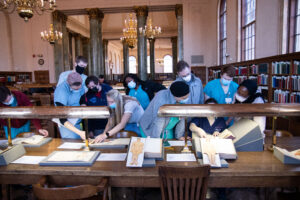On February 21, medical students visited University Libraries to learn about the history of medicine. They examined historical representations of human anatomy over the centuries using materials drawn from the rare book collection at the Wilson Special Collections Library.

“Anatomy Day,” which was an annual event before the pandemic, resumed on February 21 at Wilson Library. Fifty medical students visited Wilson to utilize the rare books collection to learn more about the history of their field.
Twenty-five fourth-year medical students in the month-long clinical anatomy elective course were interested in learning more about the fields in which they will soon match for residency. These students are preparing for residency programs in orthopedics, otolaryngology and head/neck surgery, neurosurgery, obstetrics and gynecology, surgery, urology and emergency medicine. This elective course is co-directed by Kurt Gilliland and Ed Kernick with instruction by Scott Parnell, Linda Levitch, and Jim Alb, all of the Department of Cell Biology and Physiology.
In addition, 25 first-year medical students who are taking an elective course in medical education were learning about the history of medical education. This course focuses on learning theory, curriculum, teaching, and educational scholarship, with many students continuing on in the medical education Scholarly Concentration Program. Gilliland and Gary Beck Dallaghan co-direct this course.
The University Libraries has an extensive rare book collection. Of its many books, several of the most noteworthy original books are De Humani Corporis Fabrica Libri Septem by Andreas Vesalius (1543), Tables of the Skeleton and Muscles of the Human Body by Bernard Siegfried Albinus (1749), The Anatomy of the Humane Body by William Cheselden (1713), and Anotomia Del Corpo Humano Di Giouanni Valuerde by Juan Valverde De Amusco (1606). The collection also includes original books by Bartolomeo Eustachi (1707 and 1722), William Cruickshank (1790), Charles Etienne (1546), Albrecht Von Haller (1756), Pietro Da Cortona (1741), and Antonio Maria Valsalva (1740).
The School of Medicine thanks the following for their expertise in organizing this event: Nadia Clifton (Special Collections Engagement Librarian), Dawne Lucas (Technical Services Archivist), Elizabeth Ott (the Frank Borden Hanes Curator of Rare Books), and Emily Kader (Associate Curator of the Rare Book Collection).